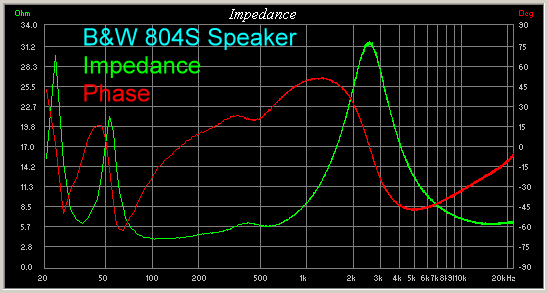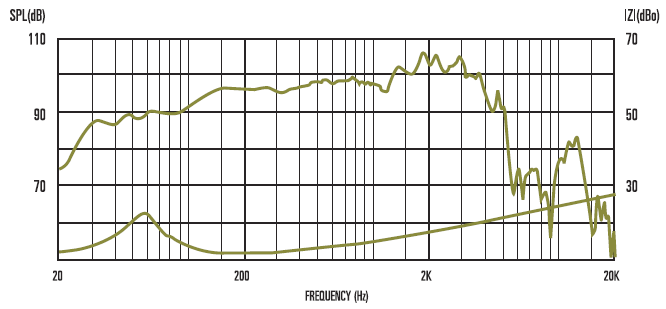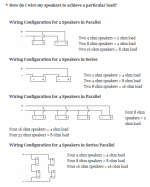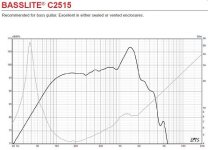Hi,
I'm newbie on this forum, bass player in seek for building a 15" extension cab with boomer and tweeter.
My amp requires 8 ohm for an external cab which paired with internal speaker/tweeter loads 4 ohm to give 400W vs 250W for 8 ohms.
Problem : I plan to use in my future cab an Eminence Basslite c2515 (4 ohm) with a Monacor HT30 tweeter (8 ohm).
Custom crossover design is OK regarding frequencies , my concern is about the load, how to get the 8 ohm my amp requires ?
Thanks for any advice.
I'm newbie on this forum, bass player in seek for building a 15" extension cab with boomer and tweeter.
My amp requires 8 ohm for an external cab which paired with internal speaker/tweeter loads 4 ohm to give 400W vs 250W for 8 ohms.
Problem : I plan to use in my future cab an Eminence Basslite c2515 (4 ohm) with a Monacor HT30 tweeter (8 ohm).
Custom crossover design is OK regarding frequencies , my concern is about the load, how to get the 8 ohm my amp requires ?
Thanks for any advice.
There is no sensible way to convert a 4 ohm bass driver to 8 ohms load except to wire two in series.
If your amp genuinely can't drive 4 ohms without going outside its output transistors safe operating area, you are just stuffed here.
At the design stage with an amplifier, you'd usually double up the output transistors in an 8 ohm design to give it enough current drive to take a 4 ohm load.
If your amp genuinely can't drive 4 ohms without going outside its output transistors safe operating area, you are just stuffed here.
At the design stage with an amplifier, you'd usually double up the output transistors in an 8 ohm design to give it enough current drive to take a 4 ohm load.
Hi,
I'm newbie on this forum, bass player in seek for building a 15" extension cab with boomer and tweeter.
My amp requires 8 ohm for an external cab which paired with internal speaker/tweeter loads 4 ohm to give 400W vs 250W for 8 ohms.
Problem : I plan to use in my future cab an Eminence Basslite c2515 (4 ohm) with a Monacor HT30 tweeter (8 ohm).
Custom crossover design is OK regarding frequencies , my concern is about the load, how to get the 8 ohm my amp requires ?
Thanks for any advice.
Forget about these numbers. They mean nothing to your amp. You are talking about active resistance. When you introduce crossover, your speaker will become complex system with reactive resistance. That reactive resistance will be the load for your amplifier. So, say you have a speaker with 4 Om DC resistance and poorly designed crossover with reactive resistance ( in between 20 Hz and 20 KHz ) , say 2 Om, than total resistance become even less than 2 Om.
Just an example.
Last edited:
Unless you're doing something really silly (like putting a 4ohm resistor across a 4ohm driver), I can't see how you'd ever get below the 4ohm resistance of the driver. Got a schematic?
OP, have you already bought the Eminence woofer?
Easy. I know that we cant trust no one nowadays but anyway, here is example:
804S Floor-Standing
â—� Design: Three-Way Ported
â—� Drivers: One 1" Aluminum Dome Tweeter,
One 6" Kevlar Midrange, Two 6-1/2"
Woofers
� MFR: 38 Hz - 22 kHz ± 3 dB
â—� Crossover: 350 Hz, 4 kHz
â—� Sensitivity: 90 dB/2.83V @ 1m
â—� Impedance: 8 Ohms (Nominal)
â—� Dimensions: 40.2" H x 9.4" W x 13.8" D
â—� Weight: 62 Pounds/Each
â—� Available Finishes: Cherry, Rosenut, Black
Ash
â—� MSRP: $4,000/Pair USA
An externally hosted image should be here but it was not working when we last tested it.

Producer says Impedance is 8 Ohms (Nominal), but from the pictures above it is clear that reactive resistance is close to 3 Om, at one particular spot. Everything is possible
Last edited:
No no no.
That's literally just the manufacturer misrepresenting. Those are a pair of 8ohm (nominal, =~6ohm minimum) woofers in parallel. Nothing more.
The phase angle just tells you the time relationship between current and voltage. Not irrelevant, but definitely different.
Rod Elliott has done some great articles on this sort of thing.
Chris
That's literally just the manufacturer misrepresenting. Those are a pair of 8ohm (nominal, =~6ohm minimum) woofers in parallel. Nothing more.
The phase angle just tells you the time relationship between current and voltage. Not irrelevant, but definitely different.
Rod Elliott has done some great articles on this sort of thing.
Chris
No, better to use the (2x) drivers in series for 8 ohms so that you can play with your amp set.I haveńt got any speaker yet, thanks for your answers but I'm a bit lost in those resistance considerations . Does a specific crossover design allow to give this 8 ohm load with a 4/8 ohm speaker pair ?
Or go with the other equivalent driver 8 ohm to your specification reference above.
It's worth explaining something about PA drivers. They are usually stacked in vertical pairs or quads. This is because a vertical array has great advantages in a hall. The acoustic power falls off at a slower rate with distance. The lobe is strongly horizontal too.
If you were using a pair of PA drivers, you'd probably want 2X 4 ohms in series for 8 ohm load.
With 4 drivers stacked vertically, you'd use two pairs of 8 ohm drivers wired in series/parallel.
Eminence Speaker is proud to offer unparalleled customer support | Eminence Speaker
FWIW, Eminence do some standard crossovers designed for their drivers with horn tweeters. It's quite a deep business actually. I expect they would advise you.
If you were using a pair of PA drivers, you'd probably want 2X 4 ohms in series for 8 ohm load.
With 4 drivers stacked vertically, you'd use two pairs of 8 ohm drivers wired in series/parallel.
Eminence Speaker is proud to offer unparalleled customer support | Eminence Speaker
FWIW, Eminence do some standard crossovers designed for their drivers with horn tweeters. It's quite a deep business actually. I expect they would advise you.
Attachments
Last edited:
Hi,
Use a Beyma driver (as in a monitor type enclosure) that is the coax equivalent to your first option Beyma 15KX
Beyma Speakers - Beyma 15KX speaker - Beyma 15KX 600 watt 15" coaxial speaker for all full range applications. Beyma 15KX coaxial and other Beyma 15" coaxial speakers here.
Or use their new substitute Beyma 15CXA400Fe or Beyma 15CXA400Nd
Beyma Speakers - Beyma 15CXA400Nd lighweight neodymium 15" coaxial speaker - Beyma 15CXA400Nd 15" coaxial handles a powerful 400 watts AES. Beyma 15CXA400Nd 15" coaxial is extremely sound and warm sounding.
Use a Beyma driver (as in a monitor type enclosure) that is the coax equivalent to your first option Beyma 15KX
Beyma Speakers - Beyma 15KX speaker - Beyma 15KX 600 watt 15" coaxial speaker for all full range applications. Beyma 15KX coaxial and other Beyma 15" coaxial speakers here.
Or use their new substitute Beyma 15CXA400Fe or Beyma 15CXA400Nd
Beyma Speakers - Beyma 15CXA400Nd lighweight neodymium 15" coaxial speaker - Beyma 15CXA400Nd 15" coaxial handles a powerful 400 watts AES. Beyma 15CXA400Nd 15" coaxial is extremely sound and warm sounding.
Thanks for the references. I'd prefer stay on dedicated bass speakers for their typical unbalanced response on frequencies that gives the tonal personality we request for our instrument sounding. Then those are light for handling purpose as our cab and amplifiers often move  cheaper also
cheaper also
Regarding speakers arrangement, I got this info as 2 speakers or 4 speakers are common cab combination. my original question somehow comes from this, as two 8 ohm speakers (boomer + tweeter) in parallel render basically 4 ohm, but the crossover additional components adjusts to 8 ohm, so I wonder how this could match lower impendance drivers I plan.
Even missed that Eminence had specific crossover products, I'll ask them for sure.
Regarding speakers arrangement, I got this info as 2 speakers or 4 speakers are common cab combination. my original question somehow comes from this, as two 8 ohm speakers (boomer + tweeter) in parallel render basically 4 ohm, but the crossover additional components adjusts to 8 ohm, so I wonder how this could match lower impendance drivers I plan.
Even missed that Eminence had specific crossover products, I'll ask them for sure.
Hi,Regarding speakers arrangement, I got this info as 2 speakers or 4 speakers are common cab combination. my original question somehow comes from this, as two 8 ohm speakers (boomer + tweeter) in parallel render basically 4 ohm, but the crossover additional components adjusts to 8 ohm, so I wonder how this could match lower impendance drivers I plan.
You must be confused by now. Let's see if "your info" is right?!
2x 4 ohms drivers in series (like in a cab combo/guitar) = 8 ohms
2x 16 ohms drivers in parallel » 8 ohms
4x drivers (8 ohms) like in a "common cab combination" in series/parallel = 8 ohms
4x drivers (4 ohms) like in a "common cab combination" in series/parallel = 4 ohms
2x 8 ohm drivers (boomer + tweeter) in parallel = 8 ohms
2x 4 ohm drivers (boomer + tweeter) in parallel = 4 ohms
Unfortunately a call to Eminence will not save you from despair...
My case, Uh, isn't it 4 ohms without crossover ? Btw I asked Eminence for their advice.Hi,
You must be confused by now. Let's see if "your info" is right?!
....
2x 8 ohm drivers (boomer + tweeter) in parallel = 8 ohms
....
As I think I go a dead end this way, I went in more alternative speakers to fit my requirements, so sharing with people, here is the bassman geas :
Rock frequency curve : linear 100-1k, maybe scooped, 2k peak, high Db rendering
Light : ideally under 3kg, over 5 kg : no way !
Cheap : 130 bucks, 200 in just got paid mood
Speakers in this range :
Eminence Basslite C2515 - nice curve - 2,6kg - 170€ - 4 ohm
Celestion BL15 400x - nice curve - 4,9kg - 120€ - 8 ohm
Celestion BN15 400x - nice curve - 2,6kg - 220€ (several offers at 330€
Sica 15BP 2.5 CS - small 2k kick - 5,4kg
 - 8 ohm
- 8 ohmSica 15BS 2.5 PL - nice scooped curve - 3,3 kg - 130€ - 8 ohm
Celestion BN15 surges ahead as there's a 300 model alternative, a bit less expensive, lighter, but difficult to find, dealing a 300w max output enough for my config. Sica I never heard before is an interresting option with the Neodym model.
Just need now a 8 ohm crossover matching the frequencies, tuto here allow to achieve this
I really don't know what the question is here. A dedicated bass driver of this sort is not going to be easy to integrate with any sort of tweeter IMO. Question of complexity of the filter required and low crossover point. That peak at 1.5kHz is problematic. I expect it falls off if the speaker isn't pointing directly at you, and the overall power delivery is fairly flat, but still...
What did Eminence say?
I don't want to write an essay on how filters work, but with a single bass driver, you need an 8 ohm bass driver for sure.
What did Eminence say?
I don't want to write an essay on how filters work, but with a single bass driver, you need an 8 ohm bass driver for sure.
Attachments
Last edited:
Thanks, no more question at this point, I'll go for a 8 ohm speaker.
I just shared some information on specificity of bass guitar speakers. The constrainst we have is to mix with other instruments and singer, deal with the room or outdoor we play, the assistance... Any "accident" in the sound produced becomes personality in such context and helps sustaining our play
Don't know much about crossover design in bass amplifiers, the markbass amplifier I own has this one :
Considering my extension cab I'll put a Celestion BN15-300x

along with a Monacor Ht30 tweeter,

the crossover point will be around 4,5 kHz, could have been 2,6kHz with a C2515.
I'll go for a 1st or 2nd order crossover
I just shared some information on specificity of bass guitar speakers. The constrainst we have is to mix with other instruments and singer, deal with the room or outdoor we play, the assistance... Any "accident" in the sound produced becomes personality in such context and helps sustaining our play
Don't know much about crossover design in bass amplifiers, the markbass amplifier I own has this one :
An externally hosted image should be here but it was not working when we last tested it.
Considering my extension cab I'll put a Celestion BN15-300x

along with a Monacor Ht30 tweeter,

the crossover point will be around 4,5 kHz, could have been 2,6kHz with a C2515.
I'll go for a 1st or 2nd order crossover
You're actually posting the 4 ohm version of the Celestion Bass - BN15-300X - Celestion - Guitar, Bass & Pro Audio Speakers, but the 8 ohm isn't far different.
The MONACOR INTERNATIONAL : HT-30 seems to recommend 5kHz 2nd order.
Complete guess, but I'd think a 0.5-1.0mH coil on the bass, and something like 3.3uF and 0.3mH on the tweeter plus any attenuation required would be a start.
No idea if the levels will match, and you're gonna let in a lot of cone breakup from the bass, but it's probably about the best you can do.
The MONACOR INTERNATIONAL : HT-30 seems to recommend 5kHz 2nd order.
Complete guess, but I'd think a 0.5-1.0mH coil on the bass, and something like 3.3uF and 0.3mH on the tweeter plus any attenuation required would be a start.
No idea if the levels will match, and you're gonna let in a lot of cone breakup from the bass, but it's probably about the best you can do.
I know it might be difficult to explain, but don't you need a driver with a ""good linearity""Rock frequency curve : linear 100-1k, maybe scooped, 2k peak, high Db rendering
- nice scooped curve -
...
Hi,
A bass combo can have an external speaker socket.
If the internal speaker remains connected and an 8 ohm
extension is required, then the amplifier load is 4 ohm.
The extension cab is best built with identical drivers
and box to the 8ohm that are in the combo.
It will go 4 to 5 dB louder with the extension.
If the internal speaker is disconnected and an 8ohm
extension is required, you cannot use a 4 ohm driver
as the extension. You want 8 ohm and a better bigger
driver and box for the extension to make it worthwhile.
If you have the former case and want to build a bigger
and better box, its easy to change the speaker socket
so that the internal speaker is disconnected. You can
then use a bigger, better external 4 ohm cabinet,
or two 8 ohm extension speakers in parallel.
rgds, sreten.
A bass combo can have an external speaker socket.
If the internal speaker remains connected and an 8 ohm
extension is required, then the amplifier load is 4 ohm.
The extension cab is best built with identical drivers
and box to the 8ohm that are in the combo.
It will go 4 to 5 dB louder with the extension.
If the internal speaker is disconnected and an 8ohm
extension is required, you cannot use a 4 ohm driver
as the extension. You want 8 ohm and a better bigger
driver and box for the extension to make it worthwhile.
If you have the former case and want to build a bigger
and better box, its easy to change the speaker socket
so that the internal speaker is disconnected. You can
then use a bigger, better external 4 ohm cabinet,
or two 8 ohm extension speakers in parallel.
rgds, sreten.
Last edited:
Hi,
Also FWIW electric bass combo's never have
a x/o on the bass unit, only on the tweeter,
very often the tweeters are peizo, and x/o
design for them is not straightforward.
If a combo has a tweeter and the extension cabinet
is used in parallel, you can omit the tweeter from
the extension cabinet, and add a switch to boost
the tweeter level, or add an L-pad for variable
tweeter level, if either option is really needed.
rgds, sreten.
Also FWIW electric bass combo's never have
a x/o on the bass unit, only on the tweeter,
very often the tweeters are peizo, and x/o
design for them is not straightforward.
If a combo has a tweeter and the extension cabinet
is used in parallel, you can omit the tweeter from
the extension cabinet, and add a switch to boost
the tweeter level, or add an L-pad for variable
tweeter level, if either option is really needed.
rgds, sreten.
I know it might be difficult to explain, but don't you need a driver with a ""good linearity""
The speaker configuration of musical instrument amps like a Marshall or a Fender are different from monitor speakers. They are designed to create a "sound" of their own.
Many have peaks or dips in frequency response to make them "stand out" or "get out of the way" of other instruments and vocals. The band decides on the "sound" they want on stage and chooses amps for each instrument accordingly.
This mainly applies to small bands who hand carry their equipment. A major band would use stage monitors and a mixing engineer to tailor the sound of each instrument.
- Status
- This old topic is closed. If you want to reopen this topic, contact a moderator using the "Report Post" button.
- Home
- Loudspeakers
- Multi-Way
- Crossover impedance

